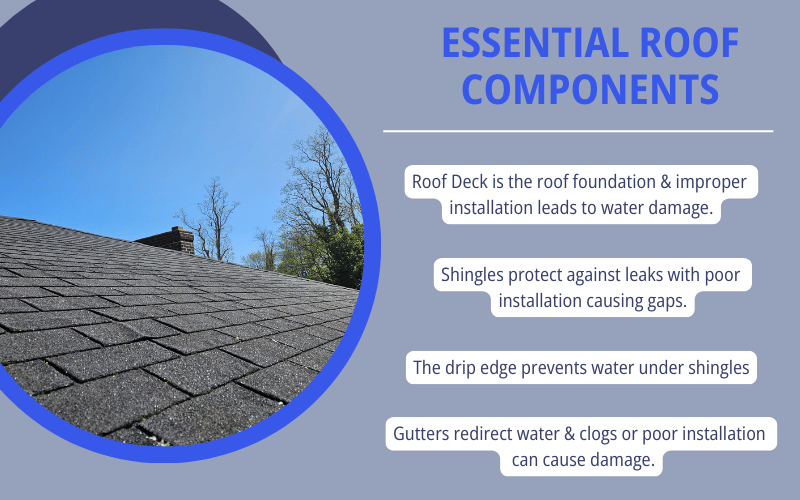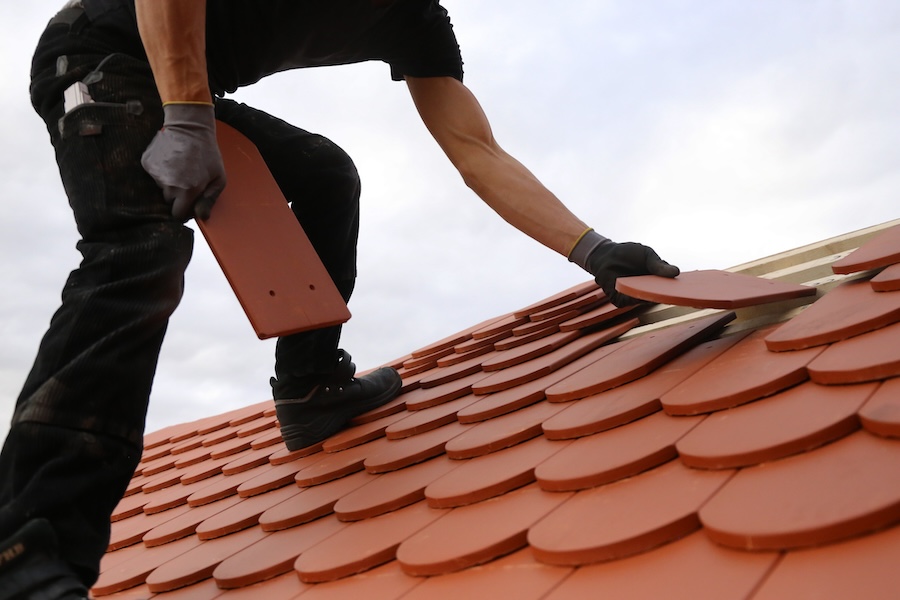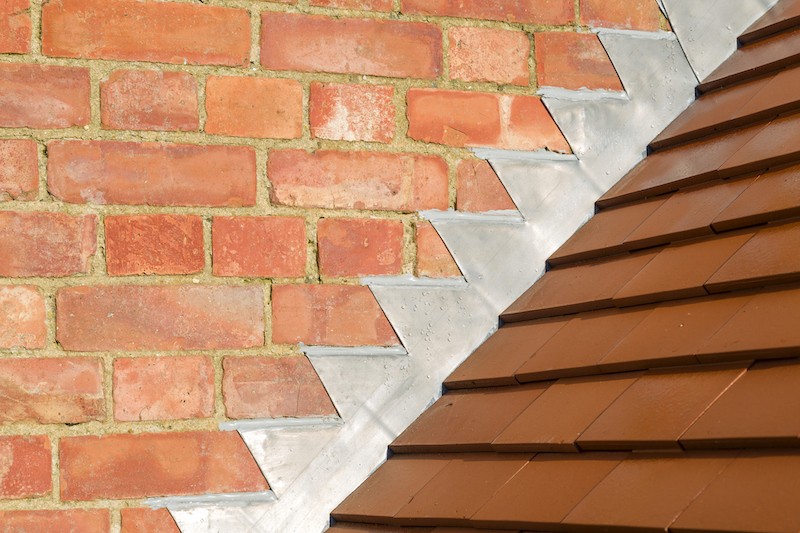Roof flashing is an important part of your roof, and proper installation is necessary to increase the longevity of your roof. Properly installed roof flashing directs water away from vulnerable areas, such as intersections between the roof and walls, chimneys, or vents, protecting the roof from leaks and damage. Flashing can be made from materials like stainless steel, copper, or aluminum, and is essential for maintaining a watertight seal.
Understanding Roof Flashing: The Essentials
Roof flashing is a critical component that helps protect your roof from water damage. Typically, it’s a thin layer made from durable, weather-resistant materials such as stainless steel, copper flashing, sheet metal, or aluminum flashing. Each material offers distinct benefits: stainless steel is known for its strength and durability, copper for its longevity and recyclability, and sheet metal for being cost-effective while still providing decent weather resistance.
The Primary Function of Roof Flashing
The primary function of flashing is to create a watertight seal at points where different components of your roofing system meet. It’s essential for preventing water penetration at vulnerable areas like roof valleys, intersections of various roofing materials, and where your roof meets vertical walls or a chimney. In these vulnerable areas, proper flashing installation directs water into gutters and away from the structure, preventing water infiltration and roof leaks. Without proper flashing, water from harsh weather conditions such as rain, snow, or runoff could easily seep into places where roof penetrations occur, leading to structural damage like rot, mold, rust, and costly repairs.
Installing new flashing during a roof replacement or with regular inspections ensures your roof’s structural integrity and watertight barrier remain intact. Whether you’re dealing with a metal roof or a flat roof, flashing plays a key role in maintaining the durability of your roofing system. Regular maintenance and using the right materials for flashing, like copper, stainless steel, or plastic flashing, will help ensure the longevity of your roofing material and prevent water from reaching areas where it can cause expensive damage, including rotting the roof deck or damaging roof valleys.

Roof Flashing Types
There are various types of roof flashing, each designed to excel at protecting specific areas of your roof from water damage. These different flashing solutions provide tailored protection by creating secure barriers where the roof meets other structures or components. Depending on the location and needs of your roof, each type of flashing ensures a watertight seal and helps prevent costly repairs from water infiltration.
- Apron Flashing: Often overlooked, this flashing protects your home from water infiltration where the roof meets a vertical wall, directing water into the gutters to prevent leaks.
- Continuous Flashing: Also known as “long length” flashing, it provides a seamless, one-piece solution to waterproof the intersection between a vertical wall and a sloped roof, offering consistent protection.
- Step Flashing: Essential for areas where the roof meets a wall or chimney, step flashing creates a solid, layered barrier, with each section aligning with a single shingle to ensure water flows away safely.
- Valley Flashing: Protecting the roof valleys, where roof planes intersect, valley flashing is crucial for preventing leaks, especially in areas prone to heavy rain or snow, safeguarding these vulnerable spots.
- Drip Edge Flashing: Installed along the roof’s edges, drip edge flashing channels water away from the fascia and into the gutters, effectively safeguarding the roof from water damage.
- Skylight Flashing: Specifically designed to seal around skylights, skylight flashing prevents water from leaking through the edges and ensures a tight, secure seal.
- Vent Pipe Flashing: This flashing surrounds the vent pipes on your roof, protecting the gaps between the pipe and the roofing material, preventing water infiltration around these protrusions.
- Chimney Flashing: Chimney flashing seals the intersection between the roof and chimney, directing water away from this vulnerable area to prevent leaks and protect the structural integrity of both the chimney and roof.
- Kickout Flashing: Installed at the roof-wall intersection, kickout flashing ensures that water flows into the gutters rather than running down the side of the house, preventing water damage to walls and foundations.
Roof Flashing Materials
The materials used in roof flashing vary in durability, cost, and effectiveness.
- Stainless steel is known for its strength and corrosion resistance, making it ideal for harsh weather conditions, though it tends to be more expensive and harder to install.
- Copper flashing is long-lasting and aesthetically appealing, developing a protective patina over time, but its high cost can be a downside.
- Aluminum flashing is lightweight, easy to install, and corrosion-resistant, but it’s less durable and can dent easily.
- Sheet metal flashing, often made from galvanized steel, offers an affordable option but is prone to rusting over time.
- Plastic flashing is cost-effective, lightweight, and easy to handle, but it’s less durable and may degrade over time due to UV exposure.
The best flashing material depends on the climate, budget, and specific needs of your roof. While stainless steel and copper are the most durable and long-lasting, aluminum and plastic provide more budget-friendly options. Proper installation and regular maintenance are essential to ensure long-term performance, regardless of the material chosen.

Other Essential Roof Components
Proper installation of key roofing components, such as the roof deck, shingles, drip edge, and gutters, is essential to maintaining a watertight barrier and protecting your home from water penetration and damage. Each element plays a crucial role in directing water away from the roof and ensuring that it is properly channeled into the gutters and away from vulnerable areas of the structure.
Importance of the Roof Deck
The roof deck serves as the foundation for the entire roofing system, providing a solid surface for attaching the shingles and other components. If the roof deck is not properly installed, it can lead to structural damage such as warping or weakening, allowing water to seep in and cause further issues, including mold or rot.
Properly Installed Shingles
Shingles are the primary defense against rain, snow, and other forms of precipitation. When not properly installed or aligned, they can create gaps, leaving the roof vulnerable to leaks and water infiltration. Inadequate sealing or incorrect nailing can also result in shingles lifting or curling, compromising the roof’s ability to keep water out.
Drip Edge as a Necessity
Similarly, the drip edge, which runs along the edges of the roof, is responsible for preventing water from flowing underneath the shingles and reaching the roof deck or fascia. Without proper installation, water can back up under the shingles, leading to water damage, rotting of the fascia, or damage to the roof deck.
Gutter Importance
Equally important are the gutters, which capture and redirect water from the roof to a safe drainage area. If gutters are improperly installed or clogged, water can overflow, spilling over the edges and soaking into the roof deck, siding, and foundation. This not only increases the risk of water damage but also compromises the home’s structural integrity.
The failure to install these components correctly can result in costly repairs down the line, including potential roof replacement and the need to replace rotting wood or damaged insulation. Regular inspections and maintenance are essential to ensure that these systems are functioning properly and working together to create a watertight barrier that keeps your home safe from the damaging effects of water infiltration.

Why Choose Leverage Roofing for Your Roof Flashing Needs
At Leverage Roofing, we take pride in our professional, locally owned family business serving the Carolinas. We specialize in the proper installation of every element of your roof, from the roof deck to shingles, drip edge, and gutters, ensuring that your home is protected with a watertight barrier. Our experienced team uses high-quality materials and precise techniques to prevent water penetration and damage, offering long-lasting protection for your home. With our attention to detail, we guarantee that all components work together seamlessly, preventing costly repairs down the line and maintaining the structural integrity of your roof.
In addition to our roofing services, we offer a range of solutions to meet all your home improvement needs. Leverage Roofing provides:
- Roof replacement
- Siding installation and replacement
- Roof cleaning
- Emergency roof help
- and more!
We also assist with insurance claims to ensure that your roof damage is covered, and we offer both seamless gutters and metal roofing options. With flexible hours and a commitment to community involvement across South Carolina, Leverage Roofing is here to support you through every step of your roofing project, offering the highest level of customer service. Contact us today for a free quote!
Resources:
https://www.cdc.gov/mold-health/about/?CDC_AAref_Val=https://www.cdc.gov/mold/default.htm


